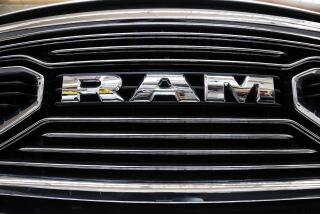Ford Accused of Concealing Evidence in Van Rollover Suits
- Share via
Ford Motor Co. faces legal sanctions for allegedly concealing evidence in lawsuits involving one of its most controversial vehicles -- the 15-passenger van that has been the subject of government safety warnings and numerous death and injury claims stemming from rollover wrecks.
Ford is being pressed to explain why it can’t locate records of key handling tests it says it performed before marketing the vans. The company says the test data probably were destroyed, a possibility that a federal judge called “very disturbing.” Plaintiffs have been seeking the records to determine what the company knew about the vans’ handling characteristics before it put them on sale.
Moreover, Ford lawyers and witnesses have been forced to retract statements made under oath in which they denied that Ford had conducted certain other tests of the vans’ stability, which plaintiffs say show the vehicles were rollover-prone.
Company attorneys, who have begun to produce data from the tests that Ford had said were not conducted, say there was no intent to deceive or withhold information, and that sanctions should not be imposed.
Sanctions for concealing or destroying evidence can include fines or a court order excluding offending lawyers or witnesses from the case. On rare occasions, judges have ruled that the guilty party is liable by default, leaving juries only to decide the amount of damages.
Motions to impose sanctions against Ford are pending in at least two cases, in Illinois and Georgia. As word of Ford’s disclosures spreads, the company could face problems in other cases around the country, where it has made similar statements to opposing lawyers and judges.
“The noose is tightening around their neck,” said James Lowe, a plaintiffs attorney seeking sanctions against Ford in a case in Chicago. “Everybody’s finding out we all were lied to.”
The Chicago case was filed by the husband of a woman who died and three people who were injured in a rollover accident in Kentucky in 1996. The company has blamed the injuries on lack of seat belt use and a drowsy driver who lost control after striking a guard rail. U.S. District Judge Robert W. Gettleman could rule on the sanctions motion as early as today.
Debate Over Safety
Ford is the leading maker of the large-capacity vans, which are widely used to shuttle commuters, church groups and college athletic squads. Over the years, vans produced by Ford and other automakers have been involved in hundreds of deadly rollovers. Ford has been sued at least 70 times, with accident victims claiming that the vans are defective because their high center of gravity makes them unusually rollover-prone -- particularly when they are used, as intended, to carry large numbers of people.
Ford says the vehicles are safe and has blamed injuries and deaths on driver errors and failure of passengers to wear seat belts. “We remain confident that this is a very safe vehicle,” said Ford spokeswoman Carolyn Brown.
An estimated 500,000 of the 15-passenger vans currently are in use, with Ford’s E-350 Super Club Wagons the most popular model. General Motors Corp. and DaimlerChrysler have produced their own versions, though DaimlerChrysler announced last June that it was ceasing production, citing sluggish sales.
From 1990 through 2001, 647 people were killed and more than 1,200 were injured in van rollovers, according to an analysis of federal accident statistics by Alice and Randy Whitfield, Maryland-based statisticians. Most of the deaths, 492, occurred in single-vehicle rollovers, in which the vans flipped over without colliding with other vehicles. In many of these cases, drivers lost control after tire failures or abrupt steering maneuvers.
Two agencies -- the National Highway Traffic Safety Administration and the National Transportation Safety Board -- have issued reports warning that the stability of the vans declines markedly with 10 or more people on board. The reports highlighted a basic paradox of the vehicles, which are marketed as spacious carriers of people and cargo yet become tipsier under heavier loads -- a fact little known to consumers.
Two insurers -- Iowa-based GuideOne Insurance and the Colorado School Districts Self Insurance Pool -- recently stopped writing new policies on the vans because of concerns about safety and claims losses.
Lawsuits against the manufacturers have focused on what they knew, or should have known, about handling problems with the vans.
In the suits against Ford, the company has acknowledged that it exempted the big vans from its internal rollover resistance standard -- a guideline Ford applies to nearly all of its other vans, pickups and SUVs. (There is no federal vehicle stability standard.)
The standard requires Ford’s light trucks to pass a computer-simulated stability test, known as the J turn. To pass, vehicles must perform a series of severe steering maneuvers at 55 mph without lifting two wheels off the ground.
But in setting the standard in the late 1980s, Ford decided to exempt models with a gross weight of more than 8,500 pounds. Fully loaded, the large passenger vans weigh more than 9,000 pounds.
Cutoff Point
In explaining the exemption, Ford witnesses have called 8,500 pounds a typical break point between commercial and personal vehicles, though the vans have been marketed to noncommercial users such as churches and schools.
Plaintiffs charge that Ford set a cutoff simply to avoid performing stability tests on the big vans. It was done “for one reason and one reason only,” said Jay Dankner, a New York plaintiffs lawyer involved in van cases. “They knew it would not pass.”
Ford says it ran a different though comprehensive set of performance tests before introducing the vans in the 1970s. These tests were repeated twice, Ford says, before the launch of redesigned versions in model years 1992 and 1997.
But Ford has told plaintiffs throughout the country that it has been unable to locate reports of the tests and believes they were destroyed. Company lawyers instead have furnished videotapes of more recent tests that they say re-created the original ones.
Companies aren’t required to save paperwork forever, and they may dispose of old documents as part of a records retention policy. But they can face legal penalties for destroying records needed as evidence in litigation that is pending or expected.
Judge Gettleman, during a hearing in the Chicago case in July, criticized Ford over the missing test reports.
“I am disturbed about the destruction of this test data,” Gettleman said, according to a transcript of the hearing. “I don’t understand it. I haven’t been given a reason for it.
“To me, it’s very disturbing when you have obviously relevant corporate documents that cannot be found for some mysterious reason. The inference that you have to draw from that is that it was either recklessly destroyed or intentionally destroyed.”
Change of Testimony
Ford faces a greater challenge in explaining contradictory statements concerning stability tests the company repeatedly said it had never performed.
The tests involve a computer application, known as ADAMS, that Ford has used to test vehicle components and simulate vehicle performance, including in the J-turn test.
Ford witnesses and lawyers have said repeatedly that though the company built ADAMS models to run J-turn tests on other light trucks, it had not done so for its 15-passenger vans.
For example, Ford lawyers said last year in court papers filed in Chicago: “There has never been ADAMS computer modeling for the E-350” vans. “Plaintiffs have known this for a long time.”
In their brief, Ford’s lawyers cited the November 2001 deposition of company engineer Alfred Darold, who said ADAMS testing was not performed and would not have applied to the vans because they were exempt from Ford’s stability standard.
But Ford was forced to change its tune after a deposition last June of another Ford engineer, Michael K. McGuire. Testifying in a Georgia case filed by Rhonda Faye Baker, a high school basketball coach who was paralyzed in a rollover wreck in October 2000, McGuire startled plaintiffs lawyer G. Brinson Williams by testifying that Ford did have an ADAMS model for the 15-passenger vans.
Ford lawyers and witnesses have since confirmed that the model exists. And they acknowledged that it was used in March 2001 to simulate a J-turn test.
In an affidavit filed this week in Chicago, Thomas J. Wielenga, a plaintiffs expert, said his analysis of the ADAMS data showed that the van experienced a rollover and at least two two-wheel lifts in the J-turn test. If Ford’s stability standard had been applied, “this vehicle would have failed,” the affidavit said. Ford officials would not respond to Wielenga’s interpretation of the results.
At a hearing last month before Judge Gettleman, John Krivicich, one of Ford’s outside lawyers, acknowledged having stated incorrectly that there was no ADAMS model.
“I think mistakes have been made. Have they been done with intent? I don’t think that’s the case at all,” Krivicich said, according to the hearing transcript.
Gettleman told Krivicich that Ford had put him in a vulnerable position.
“Mr. Krivicich ... the client obviously must have told you something that isn’t true,” Gettleman said. “You have to look for cover in a sense for yourself, because they put you in a terribly embarrassing position.”
“There is no doubt,” Krivicich replied.
Krivicich did not return a phone call. The company said in a statement Thursday: “Ford did not deliberately mislead its counsel and the court.”
Seeking to defuse the situation, Ford has portrayed it as a misunderstanding. Ford said it did not think it had to produce the ADAMS model because it was a “non-validated ... hodgepodge” whose accuracy had not been fully verified.
Furthermore, Ford said, the model was created for use in a possible redesign of the vans. Because Ford witnesses believed they were being asked about past use of the model to create the current generation of vans, they believed their answers were correct, the company said in a brief filed in Chicago last week.
Attached to the brief were sworn affidavits from Darold and another Ford engineer, both of whom stated: “I did not intend to deceive anyone or withhold information.”
For their part, plaintiffs lawyers have called it a case of “unmistakable, and intentional, deception.” They have asked Judge Gettleman to strike Ford’s defense and declare them victors in the case. Gettleman has said in the past that he would be reluctant to do so but had not ruled it out.






